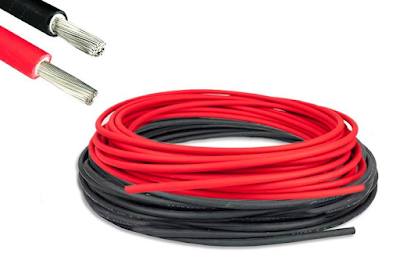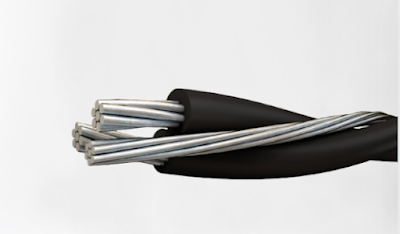How Many AMPS Can 4mm Solar Cable Take?
 |
| Solar Cable |
Introduction
In the ever-evolving world of renewable energy, solar power stands out as a beacon of sustainability and innovation. As individuals and businesses increasingly turn to solar energy solutions, understanding the intricacies of solar system components becomes crucial. One such component is the solar cable, a vital link in the solar energy chain. Among the various specifications of solar cables, the question often arises: How many amps can a 4mm solar cable take? In this comprehensive guide, we delve into the factors influencing amp capacity, optimal usage scenarios, and strategies for maximizing solar efficiency.Understanding Solar Cable Basics:
Before delving into the specifics of amp capacity, it's essential to grasp the fundamentals of solar cables. Solar cables, also known as photovoltaic (PV) cables, are designed to withstand the unique challenges of solar installations, including exposure to sunlight, extreme temperatures, and outdoor conditions. These cables connect solar panels to inverters, batteries, and other components within a solar power system, facilitating the flow of electricity generated by the panels.
The Significance of Cable Size:
Cable size plays a pivotal role in determining the maximum amp capacity it can handle. In the context of solar installations, the diameter of the cable is a crucial factor. The commonly used 4mm solar cable refers to the cross-sectional area of the conductor, typically measured in square millimeters. Larger cross-sectional areas result in lower electrical resistance and higher ampacity, enabling the cable to carry more current without overheating.Ampacity and Current Carrying Capacity:
Ampacity, or ampere capacity, refers to the maximum continuous current that a cable can safely carry without exceeding its temperature rating. In the case of 4mm solar cable, the ampacity varies depending on factors such as ambient temperature, installation method, and cable insulation material. Typically, a 4mm solar cable can safely carry currents ranging from 25 to 40 amps, making it suitable for most residential and small-scale commercial solar installations.Factors Influencing Amp Capacity:
Several factors influence the amp capacity of a 4mm solar cable, including:- Ambient Temperature: Higher temperatures reduce the ampacity of cables due to increased resistance and heat buildup. It's essential to consider the local climate and ensure proper cable sizing to account for temperature variations.
- Cable Length: Longer cable runs result in higher electrical resistance, which can limit the maximum current carrying capacity. Using thicker cables or reducing the distance between components helps mitigate voltage drop and ensures optimal performance.
- Installation Method: Proper installation techniques, such as minimizing cable bends, securing connections, and protecting cables from physical damage, contribute to maximizing ampacity and extending the lifespan of solar installations.
- Cable Insulation: The quality and type of insulation used in the cable significantly impact its ampacity and durability. High-quality, UV-resistant insulation materials enhance the cable's resilience to environmental factors and ensure reliable long-term performance.
Optimizing Solar Efficiency with 4mm Solar Cable:
To maximize the efficiency and longevity of solar installations, it's essential to adhere to best practices when selecting and installing 4mm solar cables. Consider the following strategies:- Conduct Proper Sizing: Calculate the appropriate cable size based on the maximum current expected in the system, taking into account factors such as temperature, voltage drop, and cable length.
- Choose Quality Materials: Invest in high-quality solar cables with durable insulation materials that are designed to withstand harsh outdoor conditions and provide reliable performance over time.
- Follow Installation Guidelines: Adhere to manufacturer recommendations and industry standards when installing solar cables, ensuring proper routing, termination, and protection against environmental hazards.
- Monitor Performance: Regularly inspect and monitor the performance of solar cables, checking for signs of wear, damage, or deterioration. Address any issues promptly to prevent potential safety hazards and optimize system efficiency.
Conclusion:
In conclusion, understanding the amp capacity of 4mm solar cables is essential for designing and optimizing solar power systems. By considering factors such as ambient temperature, cable length, installation method, and insulation quality, individuals and businesses can ensure the safe and efficient operation of their solar installations. With proper sizing, quality materials, and adherence to best practices, 4mm solar cables play a critical role in harnessing the full potential of solar energy and driving the transition towards a sustainable future.Visit also:
https://znergycableaustralia.blogspot.com/2024/03/what-are-challenges-involved-in-33kv.html
https://znergycableaustralia.blogspot.com/2024/03/how-are-capillary-tubes-made.html
https://znergycableaustralia.blogspot.com/2024/03/what-is-copper-armored-cable-current.html
https://znergycableaustralia.blogspot.com/2024/03/what-is-4-0-triplex-underground-wire.html
https://znergycableaustralia.blogspot.com/2024/03/what-is-3-core-16mm-armoured-cable.html
https://znergycableaustralia.blogspot.com/2023/06/benefits-of-type-409-cable-for-mining.html



Comments
Post a Comment